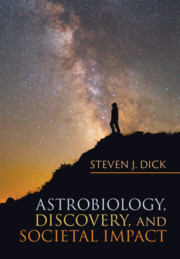Refine listing
Actions for selected content:
17002 results
6 - How Can We Envision Impact?
- from Part II - Critical Issues
-
- Book:
- Astrobiology, Discovery, and Societal Impact
- Published online:
- 26 April 2018
- Print publication:
- 03 May 2018, pp 176-206
-
- Chapter
- Export citation
Notes
-
- Book:
- Astrobiology, Discovery, and Societal Impact
- Published online:
- 26 April 2018
- Print publication:
- 03 May 2018, pp 313-342
-
- Chapter
- Export citation
7 - Astroculture
- from Part III - Impact!
-
- Book:
- Astrobiology, Discovery, and Societal Impact
- Published online:
- 26 April 2018
- Print publication:
- 03 May 2018, pp 209-239
-
- Chapter
- Export citation
1 - History
- from Part I - Approaches
-
- Book:
- Astrobiology, Discovery, and Societal Impact
- Published online:
- 26 April 2018
- Print publication:
- 03 May 2018, pp 13-36
-
- Chapter
- Export citation
2 - Discovery
- from Part I - Approaches
-
- Book:
- Astrobiology, Discovery, and Societal Impact
- Published online:
- 26 April 2018
- Print publication:
- 03 May 2018, pp 37-64
-
- Chapter
- Export citation

Bayesian Astrophysics
-
- Published online:
- 28 April 2018
- Print publication:
- 26 April 2018

Astrobiology, Discovery, and Societal Impact
-
- Published online:
- 26 April 2018
- Print publication:
- 03 May 2018
4 - Bayesian Cosmology
-
- Book:
- Bayesian Astrophysics
- Published online:
- 28 April 2018
- Print publication:
- 26 April 2018, pp 119-157
-
- Chapter
- Export citation
Preface
-
- Book:
- Bayesian Astrophysics
- Published online:
- 28 April 2018
- Print publication:
- 26 April 2018, pp xiii-xiv
-
- Chapter
- Export citation
2 - Inverse Problems in Astronomy
-
- Book:
- Bayesian Astrophysics
- Published online:
- 28 April 2018
- Print publication:
- 26 April 2018, pp 31-61
-
- Chapter
- Export citation
Frontmatter
-
- Book:
- Bayesian Astrophysics
- Published online:
- 28 April 2018
- Print publication:
- 26 April 2018, pp i-vi
-
- Chapter
- Export citation
Contributors
-
- Book:
- Bayesian Astrophysics
- Published online:
- 28 April 2018
- Print publication:
- 26 April 2018, pp viii-viii
-
- Chapter
- Export citation
3 - Bayesian Inference in Extrasolar Planet Searches
-
- Book:
- Bayesian Astrophysics
- Published online:
- 28 April 2018
- Print publication:
- 26 April 2018, pp 62-118
-
- Chapter
- Export citation
5 - An Introduction to Objective Bayesian Statistics
-
- Book:
- Bayesian Astrophysics
- Published online:
- 28 April 2018
- Print publication:
- 26 April 2018, pp 158-194
-
- Chapter
- Export citation
Contents
-
- Book:
- Bayesian Astrophysics
- Published online:
- 28 April 2018
- Print publication:
- 26 April 2018, pp vii-vii
-
- Chapter
- Export citation
1 - Bayesian Inference and Computation: A Beginner’s Guide
-
- Book:
- Bayesian Astrophysics
- Published online:
- 28 April 2018
- Print publication:
- 26 April 2018, pp 1-30
-
- Chapter
- Export citation
Participants
-
- Book:
- Bayesian Astrophysics
- Published online:
- 28 April 2018
- Print publication:
- 26 April 2018, pp ix-xii
-
- Chapter
- Export citation

Cosmic Magnetic Fields
-
- Published online:
- 21 April 2018
- Print publication:
- 12 April 2018
3 - Stellar Magnetic Fields
-
-
- Book:
- Cosmic Magnetic Fields
- Published online:
- 21 April 2018
- Print publication:
- 12 April 2018, pp 47-86
-
- Chapter
- Export citation
Acknowledgments
-
- Book:
- Cosmic Magnetic Fields
- Published online:
- 21 April 2018
- Print publication:
- 12 April 2018, pp xiv-xiv
-
- Chapter
- Export citation
